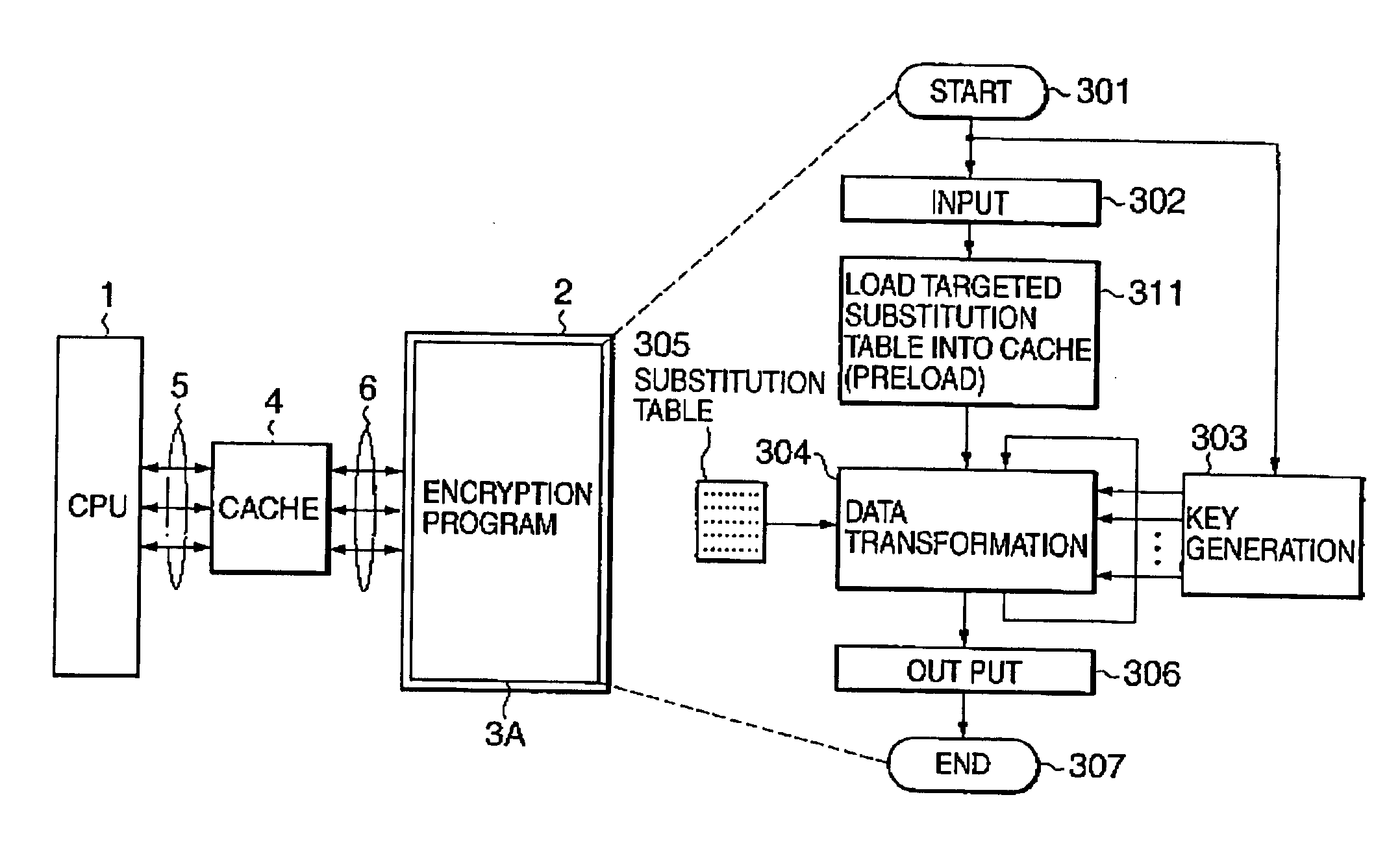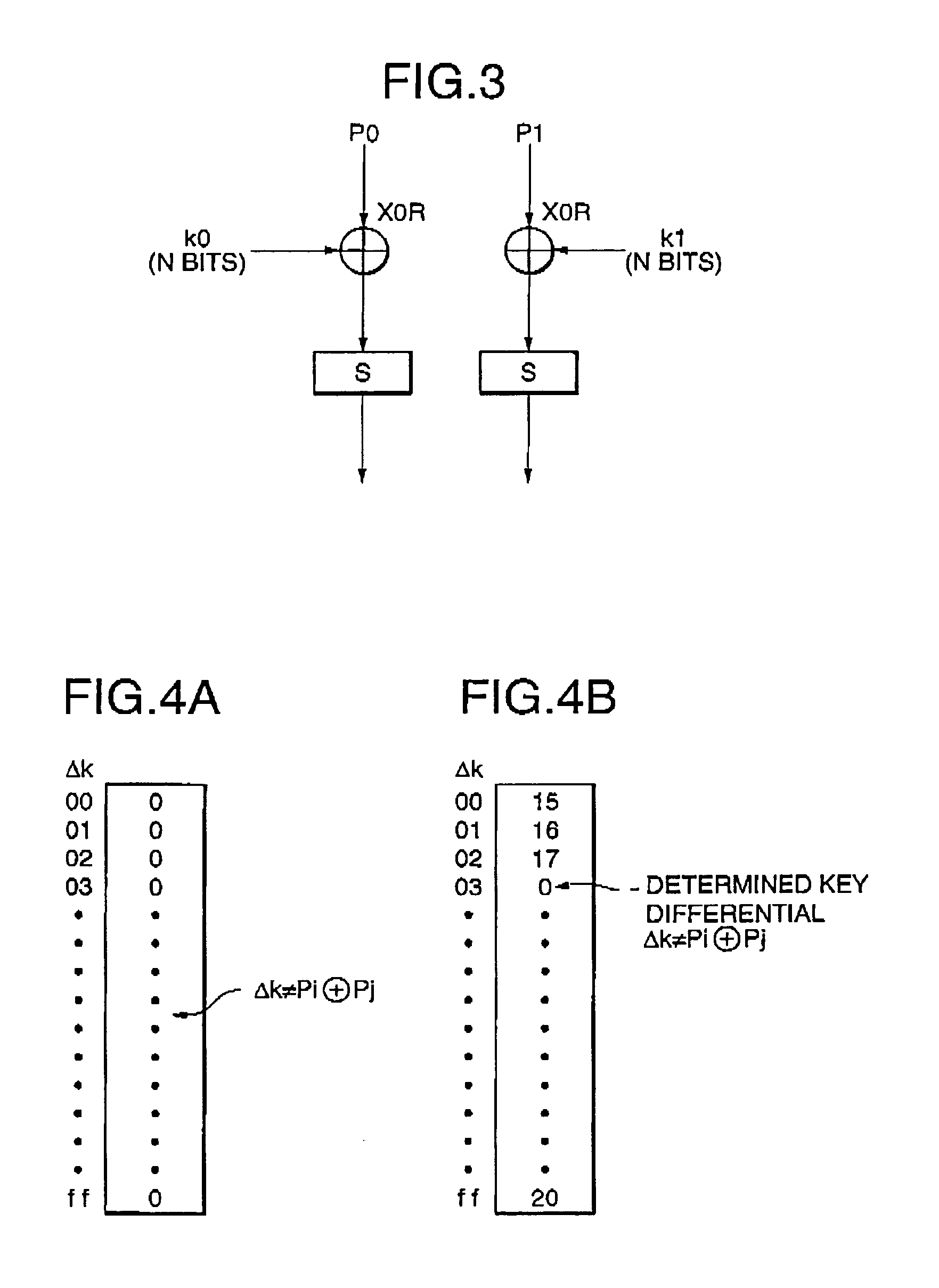Data encryption system and method
a data encryption and data technology, applied in digital transmission, memory adressing/allocation/relocation, instruments, etc., can solve the problems of ineffective countermeasures described in japanese patent application unexamined publication no. 10, and the possibility of causing different entries to be looked up in the substitution tabl
- Summary
- Abstract
- Description
- Claims
- Application Information
AI Technical Summary
Problems solved by technology
Method used
Image
Examples
first embodiment
[0078] Referring to FIG. 10A, an encryption system according to the present invention is composed of a program-controlled processor (here, CPU) 1, a memory (main memory) 2 into which an encryption program 3A is loaded from a disk or the like, and a cache memory 4. The cache memory 4 is connected to the CPU 1 by a processor bus 5 composed of data lines, address lines and control lines and is connected to the memory 2 by a memory bus 6 composed of data lines, address lines and control lines.
[0079] As known well, the cache memory 4 is a small-capacity memory allowing high-speed access compared with the main memory 2. The cache memory 4 stores the contents of frequently accessed main memory locations and addresses. When the CPU 1 issues a request for data or instruction through the processor bus 5, the cache memory 4 checks to see whether a cache hit occurs. It a cache hit occurs, then the cache memory 4 returns the hit data to the CPU 1. If a cache miss occurs, the cache memory 4 reads...
second embodiment
[0094] Referring to FIG. 11A, an encryption system according to a second embodiment of the present invention is composed of the same hardware components as the first embodiment, the CPU 1, the memory 2, and the cache memory 4, wherein an encryption program 3B is loaded into the memory 2.
[0095] Referring to FIG. 11B, the encryption program 3B is composed or a key generation section 303 and a data randomizing section including an input section 302, a data transformation section 304 including a used-entry management section 312, a unused-entry loading section 313, and an output section 306. The data transformation section 304 performs substitution using the substitution table section 305, which is composed of a predetermined number of substitution tables.
[0096] The used-entry management section 312 uses a management table to manage entries, which have been actually used in encryption / decryption process among the entries of the substitution table section 305.
[0097] The unused-entry load...
third embodiment
[0103] Referring to FIG. 12A, an encryption system according to a third embodiment of the present invention is composed of the same hardware components as the first embodiment: the CPU 1, the memory 2, and the cache memory 4, wherein an encryption program 3C is loaded into the memory 2.
[0104] Referring to FIG. 12B, the encryption program 3C is composed or a key generation section 303 and a data randomizing section including an input section 302, a data transformation section 304 including a used-entry management section 312, a cache-miss generation section 314, and an output section 306.
[0105] The data transformation section 304 performs substitution using the substitution table section 305, which is composed of a predetermined number of substitution tables.
[0106] The used-entry management section 312 uses a management table to manage entries, which have been actually used in encryption / decryption process among the entries of the substitution table section 305.
[0107] The cache-miss ...
PUM
 Login to View More
Login to View More Abstract
Description
Claims
Application Information
 Login to View More
Login to View More - R&D
- Intellectual Property
- Life Sciences
- Materials
- Tech Scout
- Unparalleled Data Quality
- Higher Quality Content
- 60% Fewer Hallucinations
Browse by: Latest US Patents, China's latest patents, Technical Efficacy Thesaurus, Application Domain, Technology Topic, Popular Technical Reports.
© 2025 PatSnap. All rights reserved.Legal|Privacy policy|Modern Slavery Act Transparency Statement|Sitemap|About US| Contact US: help@patsnap.com



